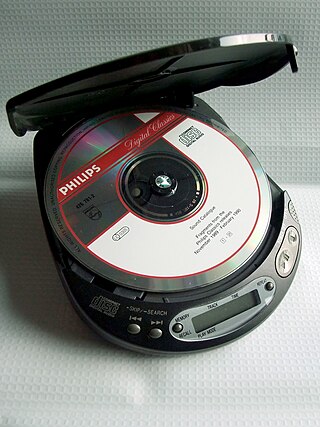
Walkman, stylised as WALKMAN (ウォークマン), is a brand of portable audio players manufactured and marketed by Japanese company Sony since 1979. The original Walkman started out as a portable cassette player and the brand was later extended to serve most of Sony's portable audio devices; since 2011 it consists exclusively of digital flash memory players. The current flagship product as of 2022 is the WM1ZM2 player.

MiniDisc (MD) is an erasable magneto-optical disc-based data storage format offering a capacity of 60, 74, and later, 80 minutes of digitized audio.

The Compact Cassette, also commonly called a cassette tape, audio cassette, or simply tape or cassette, is an analog magnetic tape recording format for audio recording and playback. Invented by Lou Ottens and his team at the Dutch company Philips and released in August 1963, Compact Cassettes come in two forms, either containing content as a prerecorded cassette (Musicassette), or as a fully recordable "blank" cassette. Both forms have two sides and are reversible by the user. Although other tape cassette formats have also existed—for example the Microcassette—the generic term cassette tape is normally used to refer to the Compact Cassette because of its ubiquity.

A CD player is an electronic device that plays audio compact discs, which are a digital optical disc data storage format. CD players were first sold to consumers in 1982. CDs typically contain recordings of audio material such as music or audiobooks. CD players may be part of home stereo systems, car audio systems, personal computers, or portable CD players such as CD boomboxes. Most CD players produce an output signal via a headphone jack or RCA jacks. To use a CD player in a home stereo system, the user connects an RCA cable from the RCA jacks to a hi-fi and loudspeakers for listening to music. To listen to music using a CD player with a headphone output jack, the user plugs headphones or earphones into the headphone jack.

A boombox is a transistorized portable music player featuring one or two cassette tape players/recorders and AM/FM radio, generally with a carrying handle. Beginning in the mid 1990s, a CD player was often included. Sound is delivered through an amplifier and two or more integrated loudspeakers. A boombox is a device typically capable of receiving radio stations and playing recorded music. Many models are also capable of recording onto cassette tapes from radio and other sources. In the 1990s, some boomboxes were available with MiniDisc recorders and players. Designed for portability, boomboxes can be powered by batteries as well as by line current. The boombox was introduced to the American market during the late 1970s. The desire for louder and heavier bass led to bigger and heavier boxes; by the 1980s, some boomboxes had reached the size of a suitcase. Some larger boomboxes even contained vertically mounted record turntables. Most boomboxes were battery-operated, leading to extremely heavy, bulky boxes.
Aiwa is a Japanese consumer electronics brand of Aiwa Co. Ltd., a subsidiary of Towada Audio holdings. The current company was established in 2017 and creates mainly audio products; the brand is also licensed to or owned by other companies in different regions of the world, producing various electronics.
Jerome "Jerry" Hal Lemelson was an American engineer, inventor, and patent holder. Several of his inventions and works in the fields in which he patented have made possible, either wholly or in part, innovations like automated warehouses, industrial robots, cordless telephones, fax machines, videocassette recorders, camcorders, and the magnetic tape drive used in Sony's Walkman tape players. Lemelson's 605 patents made him one of the most prolific inventors in American history.

Hi-MD is a magneto-optical disc-based data storage format. It was a further development of the MiniDisc. With its release in later 2004, came the ability to use newly developed, high-capacity 1 gigabyte Hi-MD discs, in the same dimensions as MiniDisc. The last recorder and player was discontinued in 2011. Blank discs stopped production in September 2012.

A portable audio player is a personal mobile device that allows the user to listen to recorded audio while mobile. Sometimes a distinction is made between a portable player, battery-powered and with one or more small loudspeakers, and a personal player, listened to with earphones.

A portable media player (PMP) or digital audio player (DAP) is a portable consumer electronics device capable of storing and playing digital media such as audio, images, and video files. The data is typically stored on a compact disc (CD), Digital Versatile Disc (DVD), Blu-ray Disc (BD), flash memory, microdrive, SD cards or hard drive; most earlier PMPs used physical media, but modern players mostly use flash memory. In contrast, analogue portable audio players play music from non-digital media that use analogue media, such as cassette tapes or vinyl records.

Discman was Sony's brand name for portable CD players. The first Discman, the Sony D-50 or D-5, was launched in 1984. The brand name changed to CD Walkman, initially for Japanese lineups launched between October 1997 and March 1998, and then entirely in 2000. Discman and CD Walkman players are no longer produced.
Andreas Pavel is a German-Brazilian cultural producer and media designer who is generally credited with patenting the personal stereo

A personal stereo, or personal cassette player, is a portable audio player for cassette tapes. This allows the user to listen to music through headphones while walking, jogging or relaxing. Personal stereos typically have a belt clip or a shoulder strap so a user can attach the device to a belt or wear it over their shoulder. Some personal stereos came with a separate battery case.
Kozo Ohsone is the Japanese manager for Sony who was credited as one of the main developers of the Walkman. While general manager of the Tape Recorder Business Division he was asked to help develop a portable audio player. Ohsone and his staff modified the existing Pressman device to create the Walkman, which was released in Japan in 1979.
The history of Sony, a Japanese multinational conglomerate, dates back to 1946.
Nobutoshi Kihara was an engineer at Sony, best known for his work on the original Walkman cassette-tape player in the 1970s and was commonly called Mr. Walkman in the press.
The Walkman A810 series is a portable media player designed by Sony. It was a flagship model in the Walkman digital player family. The model debuted in Asia in 2007, and then became available in North America. This series updates the previous Walkman A800 of the Walkman A Series, with the same hardware but different on-PC music management program.

The Walkman effect is the way music listened to via headphones grants the listener more control over their environment. The term was coined by Shuhei Hosokawa, a professor at the International Research Center for Japanese Studies, in an article published in Popular Music in 1984. While the term was named after the dominant portable music technology of the time, the Sony Walkman, it generically applies to all such devices and has been cited numerous times to refer to similar products released later, such as the Apple iPod.

The Walkman X series is a portable music player designed and released by Sony in Japan in 2009. It was marketed as a high-end, internet-enabled model in the Walkman digital player family in 2009. The model debuted in Japan in April 2009, and then became available in North America, Europe, China and also other regions. The Walkman X series was the first Walkman device to feature a touch screen and S-Master digital amplifier technologies.












